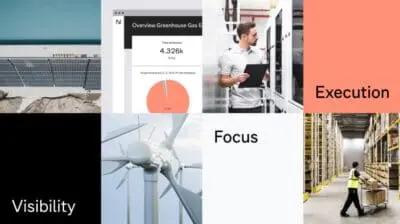Net zero, explained: what it is and how to get there

What net zero means, why it goes beyond “carbon neutral,” and how your company can achieve it.
You’ve seen the term “net zero” all over: in articles about climate change, in sustainability targets for governments and businesses, on ads for environmentally friendly products.
But what does this term mean? How is it different from “carbon neutral”? And, if it’s so important to achieve, how can your business go about actually getting there?
What is net zero?
Net zero is a state in which the total greenhouse gases emitted to the atmosphere are negated by an equivalent amount of greenhouse gas removal.
In simpler terms, reaching net zero means that you don’t contribute any additional greenhouse gas to the atmosphere on balance – whatever you emit, you compensate with proportionate removal.
Getting to net zero
We need to reach global net zero by 2050 to mitigate the most harmful consequences of climate change. The graph below shows an example timeline for getting there:
To achieve global net zero, individual countries must collectively get there; and for that to happen, the companies operating within those countries need to get there first.
For a company to reach net zero, the first step is to reduce its emissions as much as it can. This includes both the business’s owned emissions from its operations and, vitally, its scope 3 emissions from its value chain. Reducing these scope 3 emissions requires working with suppliers – which has traditionally been a time-intensive manual process, but which Normative’s Carbon Network has begun to greatly accelerate with the help of automation.
However, despite a business’s best efforts, there will almost always be some leftover emissions – called “residual emissions” – that can’t be eliminated. The second step toward reaching net zero is to then purchase high-quality carbon removal to compensate these residual emissions.
There are no shortcuts along the way. While on the surface it may seem tempting for a company to simply compensate its entire carbon footprint with carbon removal without taking any reduction measures, it’s not feasible in practice. Using high-quality carbon removal to cover all emissions would be prohibitively expensive.
In addition, there’s a risk that you won’t actually reach net zero by neglecting reduction and relying only on removal, since the technologies are still under development and we can’t be sure they will work as expected.
Where did the concept come from?
The idea of net zero originated when scientists realized that in order to mitigate global warming it will be necessary to reach a global state of balance, when it comes to greenhouse gas emissions.
The concept was then popularized by the Paris Agreement:
“Parties aim to reach global peaking of greenhouse gas emissions as soon as possible…. so as to achieve a balance between anthropogenic emissions by sources and removals by sinks of greenhouse gases in the second half of this century.” – Excerpted from the Paris Agreement
“Net zero” vs. “carbon neutral”
The terms “net zero” and “carbon neutral” are sometimes used interchangeably. They do, in theory, point to the same thing: a state in which a business contributes no additional greenhouse gas emissions to the atmosphere, on balance.
However, in practice, “carbon neutral” has become associated with the idea of paying for low-quality, ineffective carbon offsets instead of the permanent carbon removal needed to mitigate climate change. These offsets may not meet the accepted standards for net zero-aligned offsetting principles, and as such, may not move businesses toward true net zero – potentially resulting in allegations of greenwashing when businesses make sustainability claims involving these offsets.
Sustainability claims made by businesses – and especially claims of carbon neutrality – are coming under increasing scrutiny from both consumers and regulators. One-fifth of Brits have stopped buying a brand because they believed it was greenwashing. In late May 2023, the UK’s Advertising Standards Authority (ASA) said that it would begin taking action against firms who make sustainability claims, including “carbon neutral” or “climate positive,” unless the business can demonstrate that the claims are true. In the EU, the Green Claims Directive is also putting pressure on companies to provide evidence to support their sustainability claims.
As a result of the closer scrutiny around business climate claims, many businesses are moving to clarify their statements. One such example came in late June 2023, when Nestlé announced it would move away from offsetting and the use of “carbon neutral” and instead focus on reducing emissions in pursuit of a 2050 net-zero target.
Accurate, comprehensive carbon management is essential for businesses to avoid the regulatory and reputational risks associated with making misleading sustainability claims.
A small – and shrinking – window of opportunity
As the latest IPCC report made clear, we’re not on track to reach global net zero by 2050.
But, the report reminds us, we could still get there if we act quickly. To do so will require immediate and drastic action from businesses, and especially big businesses. In fact, some large businesses may soon be mandated to plan for reaching net zero by the EU’s CSDDD.
The 2050 target will be difficult to achieve – but it’s not out of reach. And the best way you can join the global effort to reach it is by advocating for it within your own company.
Empower your company to reach net zero
Normative guides you along the entire path to net zero: from your initial carbon footprint measurement, to tailored carbon reduction guidance, and finally to bespoke carbon removal.
FAQs
Frequently asked questions about net zero and how to get there.
If your organization has achieved net zero, it means you contribute no additional greenhouse gas emissions to the atmosphere, on balance. All of the emissions you emit are balanced by a proportional amount of carbon removal.
The terms “carbon neutral” and “net zero” are sometimes used interchangeably. However, in practice, “carbon neutral” has become associated with the idea of paying for low-quality, ineffective carbon offsets instead of the permanent carbon removal needed to mitigate climate change.
“Climate positive” (also referred to as “carbon negative”) means going beyond net zero and removing more carbon from the atmosphere than is emitted.
To track progress toward net zero, organizations need to use carbon accounting: a way of measuring how much greenhouse gas an organization emits.
Net-zero targets are set by both countries and organizations. In practice, the net-zero targets set by countries can only be achieved by bringing the businesses within those countries to net zero.











